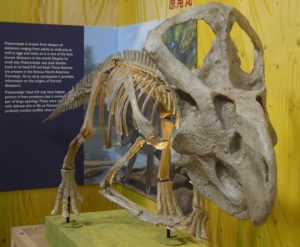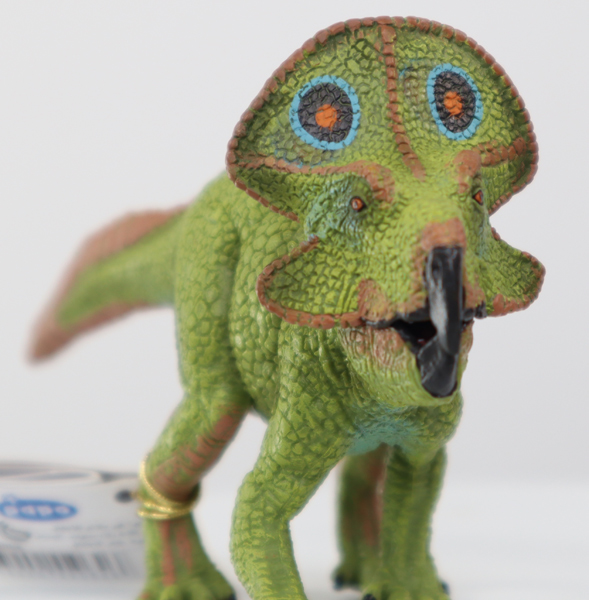Protoceratops has Something in Common with Cinderella
It is not often that palaeontology mixes with the realms of children’s stories but thanks to some research into a articulated skeleton of a protoceratopsid (small, horned dinosaur), scientists have their own version of Cinderella, with a search for the foot to fit, not a glass slipper but a footprint preserved next to the fossilised bones.
Dinosaur Footprint
For the first time, a footprint of a dinosaur has been found next to the fossilised remains of the same type of dinosaur that made the footprint. A sort of trace fossil and body fossil all found together, or as the scientists term it; an example of the first discovery of a dinosaur track in close association with an articulated skeleton.
The dinosaur playing the role of Cinderella is from a genus of horned dinosaur known as Protoceratops. Protoceratops is known as the “sheep of the Cretaceous” due to the remarkable number of fossils of this particular member of the Neoceratopsia that have been found. Dozens and dozens of specimens have been excavated from the Djadokhta Formation of the Gobi desert, including juveniles and fossilised eggs. This has enabled palaeontologists to study how these little dinosaurs changed as they grew (ontogenic studies).
Two forms of adults are known, a lightweight form with a low neck frill and a more robust form with a big frill and a pronounced “bump” on the snout, where perhaps a small horn would have been. Scientists think that these two forms of Protoceratops do not represent separate species but indicate females and males respectively. Examples of sexual dimorphism in the Dinosauria are difficult to prove due to the lack of fossils of individual species. However, with the relative abundance of Protoceratops remains to examine, the case for having differences in the ontogenic characteristics of adult females and males is certainly very strong.
Protoceratops was a heavy-set, herbivorous dinosaur that lived towards the end of the Cretaceous Period. It had a deep tail, short legs and a thick neck which supported a heavy skull. The largest specimens known, believed to be old, mature males measured no more than 2.5 metres in length.
Protoceratops Fossil Specimen
Picture credit: Everything Dinosaur
Fossil invertebrates, such as trilobites, are sometimes found next to their tracks and burrows, staff at Everything Dinosaur recall seeing a beautiful fossilised king crab and its tracks from Upper Jurassic strata of southern Germany, but this find has been trumped by palaeontologists Grzegorz Niedźwiedzki, Tomasz Singer, Gerard Gierliński and Martin Lockley who have written a paper on the body and trace fossil combination concerning the remains of a Protoceratops.
Dinosaur
The fossil was collected by a joint Polish/Mongolian research team back in 1965, but only recently studied closely and the discovery of a four-toed footprint underneath the hip bones of the dinosaur made. Such close association between tracks and their potential track-makers is extremely rare, the first line of the scientific paper on the specimen, due to be published in the journal “Cretaceous Research” states:
“Finding a dinosaur dead in its tracks constitutes the holy grail of vertebrate ichnology.”
Ichnology is the study of trace fossil such as trails, burrows and footprints. Ichnologists tend to be very cautious when it comes to identifying the type of dinosaur that made a certain type of footprint. From the fossilised bones of dinosaur’s feet they can determine the type of footprint that particular dinosaur might make, but being able to pin down a trackway or single footprint to a specific type of dinosaur is extremely difficult. In this instance, they have the body and adjacent to it the impression of the left foot of a protoceratopsid.
A Model of a Protoceratops
Picture credit: Everything Dinosaur
The picture (above) shows the Papo Protoceratops dinosaur model. To view the Papo model range: “Les Dinosaures” Papo Dinosaurs.
Footprint Next to Fossil Bones
In images, the impressions of the four toes can be clearly made out. However, just because the footprint was found adjacent to the bones, it does not mean that the last step of this Protoceratops was preserved. The footprint has to fit the foot of the dinosaur that it is associated with. Martin Lockley, one of the research paper’s authors (University of Colorado), referred to the quest to match the footprint with the animal that actually made it as the “Cinderella Syndrome”. The foot bones found at the site, match the trace fossil well, scientists are confident that the print is from the left foot of a protoceratopsid, the same type of dinosaur as the corpse, but it is unlikely that the footprint represents the very last step that this particular dinosaur took.
The research team think that the track shows an animal that was in active motion when the footprint was left. If this is correct, then it is strange that the footprint and skeleton are so close together, as if the dinosaur simply dropped “dead in its tracks” as it were. The track was not made by the foot of the animal after its death and may not represent the last steps of the individual represented by the skeleton. It is much more likely that another protoceratopsid dinosaur may have walked by that location earlier, in the place where the corpse of a different individual came to rest.
Most palaeontologists believe that Protoceratops lived in herds (or should that be flocks as they are known as the “sheep of the Cretaceous”)? Perhaps, the footprint was made by a herd member shortly before the other dinosaur met its demise.
Not only is the discovery of the body and trace fossils in close proximity a rare event in vertebrate palaeontology, the fossilised Protoceratops footprint is the first of its kind to be discovered from Upper Cretaceous strata of the Gobi desert – we think. It is certainly, a wonderful fossil and we at Everything Dinosaur have a soft spot for the Protoceratops genus. These dinosaurs may have lacked the spectacular horns of their distant descendants such as Triceratops and Styracosaurus but for us, Protoceratops remains one of our favourites of all the Dinosauria – if the shoe fits…








Leave A Comment